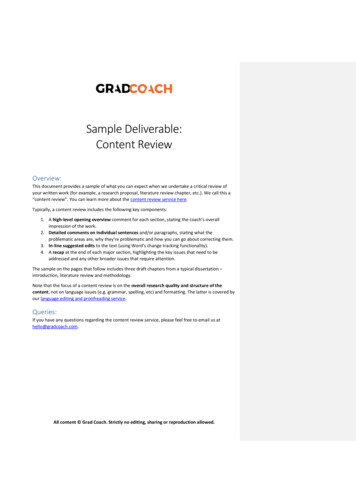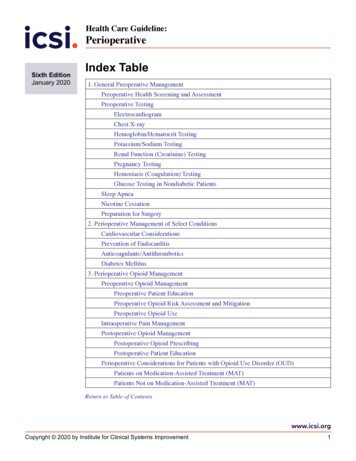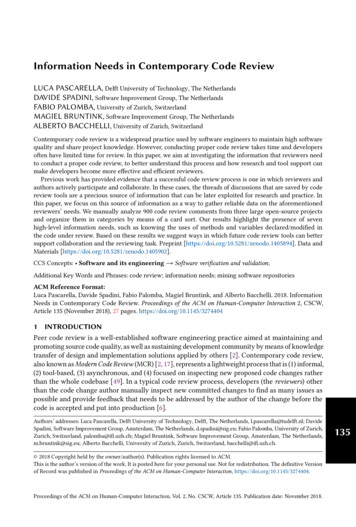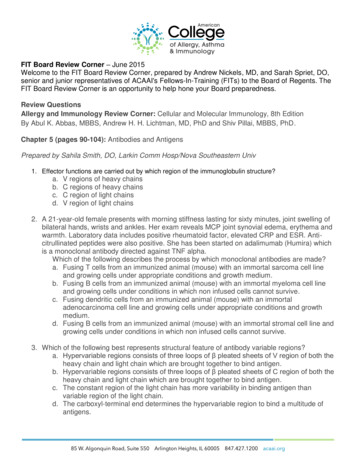
Transcription
REPORT 22A review of the research onthe past performance ofmanaged fundsSeptember 2002 - (revised June 2003)
A Review of Research on the Past Performance of Managed Fundsby the Funds Management Research CentreA Review of the Research on the Past Performance ofManaged FundsReport prepared for the Australian Securities and Investment CommissionBy theFunds Management Research Centre (FMRC)Of the Securities Industry Research Centre of the Asia Pacific (SIRCA)Report prepared by FMRC Directors:Professor David Allen (Edith Cowan University)Professor Tim Brailsford (University of Queensland)Professor Emeritus Ron Bird (University of Technology Sydney)Professor Robert Faff (Monash University)September 2002(revised June 2003)AcknowledgmentsThe following individuals and organizations have assisted with the drafting of this report and provided valuable and constructive input: Mr RobertDrake, (Australian Securities & Investment Commission, Sydney), whose comments have contributed greatly to the clarification and simplification ofsuccessive drafts; Dr David Gallagher Associate Director FMRC (University of New South Wales); Mr Paul Gerrans, Lecturer (Edith CowanUniversity); Mr Ruttachai Seelajaroen PhD Student (Australian National University); Mr Victor Soucik PhD Student (Edith Cowan University).The support of Charles River Associates is also appreciated who provided material on the UK environment which provided an excellent base for asection of this report.i
A Review of Research on the Past Performance of Managed Fundsby the Funds Management Research CentreExecutive SummaryThe Australian Securities and Investments Commission (ASIC) commissioned the FundsManagement Research Centre (FMRC) to provide a report on research findings in relation to theperformance of managed investment funds. This report would assist an ASIC project on how pastperformance information is used in investment marketing.The central issue is "how useful is past performance information when consumers (or their advisers)are selecting an Australian managed fund?"In this paper we undertake an extensive review of the academic literature on the "persistence" ofmanaged fund performance.The academic studies look at whether funds' past performance is related to their future performance.If a fund's performance is consistently above (or below) the average performance for a group ofsimilar funds, this is called "persistence". Evidence of relative persistence has importantimplications for investor choices between funds.Of the 100 or so relevant studies written over the past 40 years, we have focused on the more recentstudies and those studies with the more robust methodology.The majority of these studies look at US funds whilst a number have examined UK funds. Wereview their major findings vis-a-vis performance persistence. We also consider studies of theperformance of Australian funds and devote more detail to a few of the larger studies. A majorityof studies have examined equity funds, but some consider fixed interest funds and superannuationfunds.Although the studies address a common topic, they are characterised more by their differences thansimilarities: the studies cover different time periods, use different benchmarks and reach differentconclusions. The Australian studies are broadly consistent with the pattern of overseas research.We have kept in mind the situation facing retail investors and focused on the studies which are mostrelevant to real world situations: Returns need to be adjusted for fees. Most consumers have an investment horizon of at least several years and frequent switchingbetween funds would incur costs and inconvenience. The risk level of different funds is a significant factor.What can we conclude from this broad-ranging literature? Performance comparisons can be quite misleading if not done properly. Returns are only meaningful if adjusted for risk/volatility or comparing "like withlike".ii
A Review of Research on the Past Performance of Managed Fundsby the Funds Management Research Centre The risk-adjusted studies involve complicated computer analyses that are onlyavailable to research houses and academics. They do not reflect the informationavailable to retail investors via advertisements, league tables or formal offerdocuments. The risk-adjusted studies therefore measure the potential value of pastperformance information in the hands of experts, not ordinary consumers. Good past performance seems to be, at best, a weak and unreliable predictor offuture good performance over the medium to long term.About half the studiesfound no correlation at all between good past and good future performance.Where persistence was found, this was more frequently in the shorter-term, (oneto two years) than in the longer term. The longer-term comparison may be morerelevant to the typical periods over which consumers hold managed funds. More studies seem to find that bad past performance increased the probability of future badperformance. Where persistence was found, the "out-performance" margin tended to be small.Where studies found persistence, some specifically reported that frequentswapping to best performing funds would not be an effective strategy, due to thecost of swapping. Where persistence was found, studies came to inconsistent conclusions aboutwhich time periods (historical and future) were correlated. However, Soucik(2002) has investigated this in detail. The general pattern appears to besymmetrical. Short-term past performance is only correlated with short termfuture performance. Longer term future performance is only correlated (if at all)with longer term past performance.There are plausible explanations for these conclusions about the low persistence of pastperformance. The methods which work best in one set of market conditions will not work best atother times. For example, value and growth style managers tend to excel at differenttimes. However, it is hard for a consumer to predict the likely market conditions overthe next few years. One of the problems with many of these studies is that they mightnot track a manager through a full cycle of market conditions. Fund managers constantly strive to match the performance of competitors. If onefirm is outperforming its peers, others will try to copy its methods and/or headhunt its staff. If itattracts a large inflow of funds it is likely to be difficult to place these funds and maintainrelative performance, if it is an active as opposed to a passive fund. The future return on investments is extremely hard to predict, so a significant part of a fund’sperformance (compared to its peers) may be random luck. The findings are consistent with other research that shows that it is hard for fund managers toconsistently outperform the relevant benchmark.iii
A Review of Research on the Past Performance of Managed Fundsby the Funds Management Research CentreCONTENTSExecutive Summary. i1. Introduction . 12. Some Relevant Industry Features. 13. Factors to be Considered in Performance Measurement. 24. Background to the Academic Literature . 45. Customary Measures of Investment Performance. 56. Empirical Evidence . 76.1 US studies . 76.2 UK studies. 126.3 Australian work. 187. Conclusions . 24Appendix 1: Performance Measures . 25Appendix 2: Summary of major performance persistence studies, by holdingperiod . 27REFERENCES . 28iv
A Review of Research on the Past Performance of Managed Fundsby the Funds Management Research Centre1. IntroductionThe Australian Securities and Investments Commission (ASIC) commissioned the FundsManagement Research Centre (FMRC) to provide a report on research findings in relation to theperformance of managed investment funds. This report would assist an ASIC project on how pastperformance information is used in investment marketing.The central issue is "how useful is past performance information when consumers (or theiradvisers) are selecting an Australian managed fund?"Subsidiary issues include: Selecting measures of "performance" which are relevant to consumers. Examining the relationship between the past and future performance of funds. Putting any such relationship in context with other factors relevantconsumer's decision.totheThis report is a summary of the existing international literature. Our report gives a briefintroduction to the issue performance measurement and appropriate performance benchmarks. Wethen present a summary of the US and UK empirical work on performance persistence, beforereviewing Australian work in more depth. We then spend more time reviewing the latest workbeing undertaken currently at the Funds Management Research Centre, one of five research centresat the Securities Industry Research Centre of the Asia Pacific (SIRCA).12. Some Relevant Industry FeaturesThe managed funds industry consists of collective investments schemes run by professionalmanagers with the objective of producing returns for investors. Managed funds can be categorizedinto various types such as unit trusts, superannuation funds, approved deposit funds (roll-overfunds). It is also customary to differentiate between wholesale and retail funds, though consumersnow access wholesale funds via master trusts.The Australian asset management market is expected to grow by 238% to more than A 1 trillion by2015, one of the highest growth rates in the world. Such significant upsurge in the size of themanaged funds sector highlights the need for fund selection to be undertaken on a sound basis.All investors (whether they are private individuals or market professionals) would be interested inwhether good future performance can be chosen by looking at each fund's past performance.Individual consumers will be concerned about retail funds if they are directing their owninvestments but they are also interested in wholesale funds, given that most superannuation savingsare invested in this sector.Australia's funds management industry manages more than 650 billion for over nine millioninvestors. This covers superannuation, life insurance and other managed investments (unit trusts).Below are some general statistics on the industry:1SIRCA is a university based, industry sponsored, financial markets research centre. It conducts applied research into the design ofequities, futures, OTC markets and the market impacts of financial information. See website: http://www.sirca.org.au1
A Review of Research on the Past Performance of Managed Fundsby the Funds Management Research CentreWhere the Money is Invested -Retail Asset Profile June 2001Domestic Equities12%International Equities8%Australian Fixed Interest10%International Fixed Interest1%Property2%Cash19%Multi Sector48%Source: ABS and ASSIRTAustralian managed funds have substantial exposures to fixed interest securities. About 30% offunds in the ASSIRT database are pure fixed income funds, controlling 29% of funds undermanagement. About 90% of managed funds hold at least some fixed income securities as part oftheir investment portfolio. It is therefore likely to be misleading if a benchmark based purely onequity returns is applied to measure the performance of these funds.A measure of performance has to be relevant to both equity and fixed interest portfolios. It also mayneed to take into account investments in property and international equity, depending on the assetcomposition of the fund.3. Factors to be considered in Performance MeasurementThe use of past performance information is clearly linked to two related issues: What is an acceptable performance measure?A suitable measure needs to incorporate risk as well as return, given that performance figuresare inextricably linked with the riskiness of investments. Given a performance measure, can past performance be used as a guide to likelyfuture performance?3.1 Risk and abnormal returnsThe main objective of a managed fund is to maximize returns while controlling the level of risk.Much of the performance reporting and advertising focuses entirely on returns achieved. However,all portfolios of investments are subject to risk and an indication of a funds' riskiness is requiredbefore any statement about historical returns can be meaningful.Much of the US literature in the area has traditionally concentrated on mutual funds (i.e. openended funds). This is because they are the most accessible to consumers and their fluctuatingperformance can be examined from their unit prices.Academic studies concentrate on whether a fund's returns out-perform some appropriatebenchmark (which typically might be a composite market index). Performance is not superior if itcannot match that of a comparably risky diversified benchmark portfolio. One potential strategy ispassive diversification which should produce a performance which has the same return and riskcharacteristics as the market average (e.g. a composite market index). If the fund manager takes onmore risk by trying to choose winning stocks then the investor needs a measure of whether or notthe policy produced returns commensurate with the extra risk level adopted.2
A Review of Research on the Past Performance of Managed Fundsby the Funds Management Research CentreHowever, even if a strategy worked in one period there is no guarantee that it will continue to workin the next. This leads on naturally to the issue of performance persistence.If past performance is going to be of use to investors, we need to know whether past performance(good or bad) is linked to future performance (good or bad); ie "performance persistence". If thereis a link then this information can assist investors to make better investment choices. If there is nolink between past performance and future performance in a statistical sense, then knowledge ofpast performance will not help an investor in choosing a likely high performance fund or inavoiding a probable below-average performer.Even if we measure a fund's returns over a time interval accurately, this is only half the story.Measuring a fund's performance is more complicated than merely computing its realised orexpected, returns. Two sources of the complications are discussed below.3.2 Investment RiskSince returns and risks are positively correlated, a manager can improve a portfolio's return simplyby aggressively investing in more risky assets. Given that investors prefer less risk (other thingsbeing equal), investment performance measures should incorporate both these indicators: portfoliorisks and returns. However, unlike returns, there are a variety of measures of risk which can beused. We will review some of the most common methods shortly.3.3 BenchmarkingThe next issue is what we compare performance against.There are two broad investment strategies: passive diversification or an active investment strategy.If the former strategy is adopted, then the investor is seeking an appropriately diversified portfoliowhich the manager will purchase on his behalf. The investor should achieve a measure of returnand risk commensurate with that achievable on a broadly diversified portfolio. If he is trying toinvest in a liquid portfolio of Australian equities, such as the S&P 100 Australian index, then heshould have a return and risk profile similar to that of this particular benchmark. It will then beheld without much revision unless there are changes in the composition of the index.With a more active stock selection strategy, investing in a managed fund is worthwhile only if themanager can add more value than the investors could achieve themselves. Again, the fund'sperformance must be compared with an appropriate benchmark. The benchmark should be anefficient naive portfolio replicable by average investors at low costs, such as the previouslymentioned top 100 share index.Ideally we require some composite measure of both return and risk. This composite measurementindex must hold the risks of an evaluated portfolio constant, so that performance can be judged onthe basis of risk-adjusted returns. We need to measure a portfolio's performance on two dimensions;relative performance (i.e. relative to other active portfolios) and absolute performance (i.e. relativeto a benchmark).3
A Review of Research on the Past Performance of Managed Fundsby the Funds Management Research Centre3.4 Typical scenarios for retail consumersWhen looking at studies of performance, we have to consider how relevant the study is to thesituation of typical consumers.While consumers will vary in their individual circumstances, the following issues will generally berelevant to some degree in selecting an asset mix, product and fund manager: Most consumers would want to hold a fund for several years at least. For mostequity based funds, the investment horizon is at least five years. Frequentswapping involves both fees and inconvenience.Retail consumers face significant transaction and management costs for mostmanaged funds. Ongoing fees typically range from 1% for a cash or fixed interestfund to 2.5% for an equity fund. Measures of performance need to be net oftransactions costs. An investor is concerned with the dollars that subsequently endup in his pocket, not hypothetical measures.Consumers are interested in risk, including the risk of capital loss and the volatility ofinvestment value over time.We will review all of these issues in the course of this report.4. Background to the Academic LiteratureThe academic literature on the measurement of managed fund performance stretches back over 40years. The development of the Capital Asset Pricing Model (CAPM)2 from modern portfolio theory(MPT)3 created a method of measuring managed fund performance on at the basis of at least twodimensions: risk and expected return. MPT is built on the assumption that rational investors needinformation about the expected return and risk of their potential investments before they can makeinformed choices. This suggests that return and risk must be included in any performance measure.However, there are a number of different ways of measuring risk. The CAPM only looks at marketrelated risk (or beta), not total risk. The CAPM as its name suggests is an asset-pricing model.There is a range of views in the academic literature about the best asset-pricing model. Candidatesvary from the CAPM, to arbitrage pricing based models, through to various ad-hoc factor-basedmodels which have resulted from statistical exercises. In addition to studies using different pricingmodels, they also use a variety of benchmarks to represent the neutral market performance.There is an extensive academic literature on both asset-pricing models and performancebenchmarks. However, in this paper we can only report the underlying methodology for each of thevarious performance studies.The issue is made even more complex by the fact that varied results have emerged from studiesusing similar methodologies or similar benchmarks.23Sharpe (1964), Lintner (1965), Treynor (1965) Mossin (1966).Markowitz (1952).4
A Review of Research on the Past Performance of Managed Fundsby the Funds Management Research Centre5. Customary Measures of Investment PerformanceWith the development of Modern Portfolio Theory (MPT) and asset pricing theory, in particularthe Capital Asset Pricing Model (CAPM), it was immediately obvious that the analysis provided atheoretical framework that could be applied to meet the challenges of performance measurement.Treynor (1965), Sharpe (1966), and Jensen (1968) were the first to realise the potential applicationsof MPT and CAPM for investment performance evaluation.5.1 Standard DeviationMarkowitz (1952) suggested the use of standard deviation as a measure of risk. This metric measuresthe dispersion of returns from a central average value. The metric has distributional properties thatallow inferences to be drawn. For instance, if the returns produced by a fund follow a bell-shapednormal distribution, then 95 times out of a hundred the return should be within plus or minus twostandard deviations of the long term average.The greater the standard deviation, the greater the fund's volatility.5.2 The Sharpe IndexThe Sharpe ratio is a risk-adjusted measure developed by the Nobel Laureate William Sharpe.Markowitz (1952), the founder of Modern Portfolio Theory (MPT), suggested that investors chooseoptimum portfolios on the basis of their expected return and risk characteristics. As noted above, theoverall risk of a portfolio is measured by the standard deviation of its returns.Sharpe used this concept to build a "reward to variability" ratio which has become known as the SharpeIndex. The metric is calculated using standard deviation and excess return (i.e. return above a risk freeinvestment) to determine reward per unit of risk.The higher the Sharpe ratio, the better the fund's historical risk-adjusted performance. In theory, anyportfolio with a Sharpe index greater than one is performing better than the market benchmark.5.3 Jensen's AlphaJensen’s Alpha is also a reward to risk measure. However, it uses a different concept of risk. To explain,we first need to realise that this measure’s framework is taken from the capital asset pricing model(CAPM). In this model, among the assumptions, it is taken that every investor holds a diversifiedportfolio. This allows investors to diversify away some of their investment risk, leaving them exposedonly 'systematic' or non-diversifiable market-related risk.Jensen's Alpha uses only systematic risk for scaling a portfolio's return. Alpha measures the deviationof a portfolio's return from its equilibrium level, defined as the deviation of return from the risk-adjustedexpectation for that portfolio's return.For ranking purposes, the higher the alpha, the better the performance. The fund beats the market, on asystematic risk adjusted basis, if Jensen's Alpha is greater than zero, and vice versa.5
A Review of Research on the Past Performance of Managed Fundsby the Funds Management Research Centre5.4 Treynor IndexA third performance measure is the Treynor index. This is calculated in the same manner as the Sharpeindex, using excess returns on the fund, but the excess return on the fund is scaled by the beta of thefund, as opposed to the funds' standard deviation of returns.Of these three traditional measures, the regression-based Jensen's Alpha is most commonly used inacademic research. It provides a measure of whether a manager beats the market, as well as suggestingthe magnitude of over/under performance.These performance measures are explained in more detail in Appendix One.5.5 Survivorship BiasPerformance studies face a problem called "survivorship bias". This arises because some fundsdisappear during the period being studied. They may close or merge, or data on them may becomeunavailable. To the extent that being a survivor depends on past performance, using data based onsurviving funds will bias upwards the true average performance of the managed fund industry.This is because the high-performing funds will tend to be over-represented in the sample. Fundswith poor performance will tend to be merged or closed and will drop out of the sample. This maylead to predictable biases in empirical work on managed fund performance.5.6 Performance PersistencePerformance persistence can be defined as a positive relation between performance ranking in aninitial ranking period and the subsequent period.4 Two forms of persistence, absolute and relative,have been distinguished in the literature. A fund possesses absolute performance persistence if it isable to consistently beat a specific benchmark. This has implications for the Efficient MarketHypothesis, or the speed with which information is reflected into security prices. This also hasimplications about the merits of actively managed versus index funds. However, these issues arenot the focus of this paper.On the other hand, a fund possesses relative performance persistence if its performance isconsistently above the average performance of a cohort of funds. Evidence of relative persistencehas implications for investor choices between funds.Many of the early studies were prompted by the development of MPT and thus focussed onperformance relative to a market benchmark. More recently greater emphasis has been placed onthe issue of performance persistence.The academic studies use two main techniques to study performance persistence.One approach is a regression analysis of risk-adjusted returns from a benchmark (using Jensen'salpha). The studies then examine the correlation between alphas in the prior period and the laterperiod.4Carhart (1997).6
A Review of Research on the Past Performance of Managed Fundsby the Funds Management Research CentreThe second approach is to compare returns (not risk adjusted) between funds in similar assetcategories. Medians or quartiles are used to compare rankings in the prior period and the laterperiod. This is the contingency table approach.6. Empirical EvidenceThe first question in any discussion of performance is "can funds add value in the sense of 'beatingthe market'"? Early studies of managed fund performance focused on this issue. These studies weredone to test the Efficient Markets Theory. They also assist investors to decide whether it is betterto invest in an actively managed fund or an index fund. The subject is complicated, as differentresults are obtained depending on what benchmark is used. A stock market index (such as the AllOrdinaries or Dow Jones) has inherent biases. However, this whole topic is outside the scope ofthis paper, as it addresses a different issue.Recently more attention has also been focussed on whether past performance of individual fundscan be used as a guide to their future performance. Can consumers successfully use measures ofpast performance as a decision tool for fund selection? This issue is also referred to as "performancepersistence".Our review of the literature will proceed in three segments: we will begin with the US literature,this is the largest, then we will briefly look at some of the UK studies before concluding with amore in depth review of the Australian empirical work.6.1 US studiesThere are more US studies of mutual fund performance than in other countries. They tend to havelarger data sets and were among the first to use more sophisticated measurement methods.Early studies of performance persistence indicated that superior performance does not persistthrough time [see Sharpe (1966) and Jensen (1968)]. Perhaps the most influential work on the topicis that of Jensen (1968), who concluded that not only average fund performance but also individualperformance was no better than that predicted from mere random chance. Studies in the early1990s, on the other hand, suggested that some mutual funds have persistent superior performance.[Grinblatt &Titman (1992), Hendricks, Patel & Zeckhauser (1993), Goetzmann & Ibbotson (1994),Elton, Gruber & Blake (1996a), and Gruber (1996)].However, more recent studies tend to show that the persistence results may be subject to moredoubt. First, Brown, Goetzmann, Ibbotson, & Ross (1992), Brown & Goetzmann (1995), andMalkiel (1995) find that survivorship bias in the construction of the mutual fund samples may giverise to the appearance of persistent superior returns. Secondly, Carhart (1997), Daniel, Grinblatt,Titman & Wermers (1997) and Wermers (1997) report that a naive momentum investment strategycan explain the apparent persistence in performance, especially among well performing funds.7
A Review of Research on the Past Performance of Managed Fundsby the Funds Management Research CentreGrinblatt and Titman (1992) examine a sample of 279 funds over the period 1975-1984 using theeight portfolio or P8 benchmark. This benchmark consists of a composite of passive portfolioswhich are constructed to take into account size (4 portfolios), dividend yields (three portfolios) andpast returns ( one portfolio). They use regression to calculate excess returns ('alpha') for each fund.This risk adjusted measure will be positive and significant if there is superior performance. Theydivide the sample into 1975-1979 and 1980-1984 sub-periods and examine whether above-averageperformance in the earlier period is indicative of above-average performance in the later period.Their results provide weak support for the hypothesis that better than average performance persistsover time.Hendricks et al. (1993) look at no-load (i.e no entry fee) growth-oriented mutual funds from1974-1988. The data consists of quarterly returns (net of management fees) for a total sample of165 funds. They transform all returns into excess returns by subtracting the one-month USTreasury bill rate. They find stronger evidence that funds that do
This report is a summary of the existing international literature. Our report gives a brief introduction to the issue performance measurement and appropriate performance benchmarks. We then present a summary of the US and UK empirical work on performance persistence, before reviewing Australian work in more depth.











